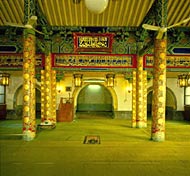 The Ox Street Mosque, located in the Guang? anmennei area in the southwestern section of the city, is the oldest and largest of the 80-odd mosques in Beijing.
The Ox Street Mosque, located in the Guang? anmennei area in the southwestern section of the city, is the oldest and largest of the 80-odd mosques in Beijing.
The Islamic faith was introduced into China during the Tang Dynasty and has followers among more than 10 Chinese ethnic groups, including the Huis, Uygurs, Ozbeks and Kazaks.
When it was first built some thousand years ago, the architecture of the Ox Street Mosque was in pure Arabic style. During its many phases of reconstruction and renovation, however, elements of Chinese traditional architecture were adopted. Today, in terms of its structure and general layout, Islamic features still prevail.
The mosque was originally built by Nasruddin, the son of an Arabic priest who came to China to preach the Islamic faith in 996 (Northern Song Dynasty).
Major renovation projects were carried out in 1442, during the time of Emperor Kangxi (1662-1722) and again after the founding of the People?s Republic of China in 1949 when the buildings were entirely repainted and redecorated.
Directly inside the front gate stands a hexagonal structure known as the Moon-Watching tower. Every year at the beginning and ending of the fast serve the moon?s waxing and waning so as to auspiciously fix the exact duration of the fast.
In front of the tower are a memorial archway and a screen wall covered with carved murals, which together form the main entrance of the mosque. Beyond it is the main hall where the congregation comes to pray. According to Islamic tradition, a Muslim in prayer must kneel down and prostrate himself in the direction of Mecca (in Beijing, to the west), which explains why the fa?ade of the main hall has an eastern aspect.
To the rear of the main hall is a group of small religious halls and stela pavilions designed in Islamic style. As the teaching of the Koran forbid the portrayal of human or animal forms, the designs and patterns in all of the decorations are composed of Arabic letters and geometrical patterns. Directly in the center of this section is the minaret, from which the muezzin calls the faithful for prayers five times a day, beginning at dawn.
In the innermost courtyard of the compound are a number of auxiliary buildings, including classrooms for religious training. In the southern part of the compound there is a very large bathhouse used for religious ablutions.












